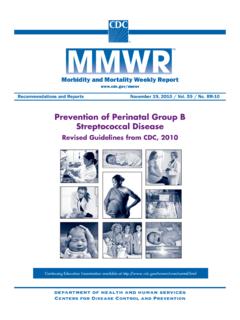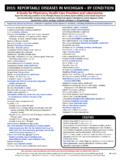Transcription of Prevention of Perinatal Group B Streptococcal Disease
1 Morbidity and Mortality Weekly Report Recommendations and Reports August 16, 2002 / Vol. 51 / No. RR-11. Prevention of Perinatal Group B. Streptococcal Disease Revised Guidelines from CDC. Centers for Disease Control and Prevention TM. SAFER HEALTHIER. HEALTHIER PEOPLE. MMWR. CONTENTS. Introduction .. 1. The MMWR series of publications is published by the Epidemiology Program Office, Centers for Disease Background .. 3. Control and Prevention (CDC), Department of Impact and Implementation of the 1996 Guidelines .. 5. Health and Human Services, Atlanta, GA 30333. Maximizing Prevention by Chemoprophylaxis .. 7. Adverse Effects and Unintended Consequences of Chemoprophylaxis .. 8. SUGGESTED CITATION Clinical Challenges.
2 11. Centers for Disease Control and Prevention . Future Prevention Technology .. 15. Prevention of Perinatal Group B Streptococcal Research Priorities and Tools To Aid Prevention .. 16. Disease . MMWR 2002;51(No. RR-11):[inclusive page numbers]. Recommendations .. 16. References .. 18. Centers for Disease Control and Prevention Julie L. Gerberding, , Director David W. Fleming, Deputy Director for Science and Public Health Dixie E. Snider, Jr., , Associate Director for Science Epidemiology Program Office Stephen B. Thacker, , Director Office of Scientific and Health Communications John W. Ward, Director Editor, MMWR Series Suzanne M. Hewitt, Managing Editor Lynne McIntyre, Project Editor Lynda G. Cupell Malbea A.
3 Heilman Beverly J. Holland Visual Information Specialists Quang M. Doan Erica R. Shaver Information Technology Specialists Vol. 51 / RR-11 Recommendations and Reports 1. Prevention of Perinatal Group B Streptococcal Disease Revised Guidelines from CDC. Prepared by Stephanie Schrag, D. Phil. Rachel Gorwitz, Kristi Fultz-Butts, Anne Schuchat, Division of Bacterial and Mycotic Diseases National Center for Infectious Diseases Summary Group B streptococcus (GBS) remains a leading cause of serious neonatal infection despite great progress in Perinatal GBS. Disease Prevention in the 1990s. In 1996, CDC, in collaboration with other agencies, published guidelines for the Prevention of Perinatal Group B Streptococcal Disease (CDC.)
4 Prevention of Perinatal Group B Streptococcal Disease : a public health perspective. MMWR 1996;45[RR-7]:1 24). Data collected after the issuance of the 1996 guidelines prompted reevaluation of Prevention strategies at a meeting of clinical and public health representatives in November 2001. This report replaces CDC's 1996 guide- lines. The recommendations are based on available evidence and expert opinion where sufficient evidence was lacking. Although many of the recommendations in the 2002 guidelines are the same as those in 1996, they include some key changes: Recommendation of universal prenatal screening for vaginal and rectal GBS colonization of all pregnant women at 35 37. weeks' gestation, based on recent documentation in a large retrospective cohort study of a strong protective effect of this culture-based screening strategy relative to the risk-based strategy Updated prophylaxis regimens for women with penicillin allergy Detailed instruction on prenatal specimen collection and expanded methods of GBS culture processing.
5 Including instruc- tions on antimicrobial susceptibility testing Recommendation against routine intrapartum antibiotic prophylaxis for GBS-colonized women undergoing planned cesar- ean deliveries who have not begun labor or had rupture of membranes A suggested algorithm for management of patients with threatened preterm delivery An updated algorithm for management of newborns exposed to intrapartum antibiotic prophylaxis Although universal screening for GBS colonization is anticipated to result in further reductions in the burden of GBS Disease , the need to monitor for potential adverse consequences of intrapartum antibiotic use, such as emergence of bacterial antimicrobial resistance or increased incidence or severity of non-GBS neonatal pathogens, continues, and intrapartum antibiotics are still viewed as an interim strategy until GBS vaccines achieve licensure.
6 Introduction Perinatal GBS Disease were issued in 1996 by the American College of Obstetricians and Gynecologists (ACOG) (6) and Group B streptococcus (GBS) emerged as the leading infec- CDC (7), and in 1997 by the American Academy of tious cause of neonatal morbidity and mortality in the United Pediatrics (8). States in the 1970s (1 4). Initial case series reported case- Those guidelines recommended the use of one of two pre- fatality ratios as high as 50%. In the early 1980s, clinical trials vention methods, a risk-based approach or a culture-based demonstrated that administering antibiotics during labor to screening approach. Providers using the risk-based method women at risk of transmitting GBS to their newborns could identify candidates for intrapartum chemoprophylaxis accord- prevent invasive Disease in the first week of life ( , early- ing to the presence of any of the following intrapartum risk onset Disease ) (5).
7 As a result of the collaborative efforts of factors associated with early-onset Disease : delivering at <37. clinicians, researchers, professional organizations, parent weeks' gestation, having an intrapartum temperature > F. advocacy groups, and the public health community in the (> C), or rupture of membranes for >18 hours. The screen- 1990s, recommendations for intrapartum prophylaxis to prevent ing-based method recommends screening of all pregnant women for vaginal and rectal GBS colonization between 35. The material in this report was prepared by the National Center for Infectious Diseases, James M. Hughes, , Director; Division of Bacterial and Mycotic and 37 weeks' gestation. Colonized women are then offered Diseases, Mitchell L.
8 Cohen, , Director. intrapartum antibiotics at the time of labor. Under both strat- egies, women with GBS bacteriuria during their current 2 MMWR August 16, 2002. pregnancy, or who previously gave birth to an infant with early- Detailed instruction on prenatal specimen collection and onset GBS Disease are candidates for intrapartum antibiotic expanded methods of GBS culture processing, including prophylaxis. instructions on susceptibility testing Before active Prevention was initiated, an estimated 7,500 Recommendation against routine intrapartum antibiotic cases of neonatal GBS Disease occurred annually (9). Despite prophylaxis for GBS-colonized women undergoing striking declines in Disease incidence coinciding with increased planned cesarean deliveries who have not begun labor or Prevention activities in the 1990s, GBS Disease remains a lead- had rupture of membranes ing infectious cause of morbidity and mortality among new- A suggested algorithm for management of patients with borns in the United States (10,11).
9 Moreover, since the release threatened preterm delivery of the 1996 guidelines, new data are available to evaluate the An updated algorithm for management of newborns effectiveness of the screening approach relative to the risk-based exposed to intrapartum antibiotic prophylaxis approach and to resolve some of the clinical challenges of imple- Although important changes have been instituted, many menting Prevention . recommendations remain the same: In light of these new data, in November 2001, CDC con- Penicillin remains the first-line agent for intrapartum sulted with multiple partners to revise the 1996 guidelines for antibiotic prophylaxis, with ampicillin an acceptable the Prevention of Perinatal Group B Streptococcal Disease , alternative.
10 Using an evidence-based approach where possible and scien- Women whose culture results are unknown at the time of tific opinion when sufficient data were lacking (Table 1). These delivery should be managed according to the risk-based updated guidelines replace CDC's 1996 guidelines. They are approach; the obstetric risk factors remain unchanged ( , intended for the following groups: providers of prenatal, delivery at <37 weeks' gestation, duration of membrane obstetric, and pediatric care; supporting microbiology labora- rupture >18 hours, or temperature > F [> C]). tories, hospital administrators and managed care organizations; Women with negative vaginal and rectal GBS screening childbirth educators; public health authorities; and expectant cultures within 5 weeks of delivery do not require intra- parents and their advocates.














